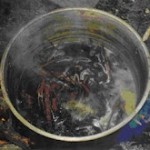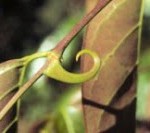Explore Articles Filed Under: Sacred Plants
Mestizo shamans in the Upper Amazon maintain relationships with two types of spirits — the spirits of the healing plants, who appear almost invariably in human form; and the protective spirits, often powerful animals or birds or human beings, or the spirits of certain plants such as the spiny palms. The animals and plants that protect the healer are the same as those that carry out the destructive will of the sorcerer.

Just what we need. More bad press about psychotropic mushrooms. You see, not only do they make you trip out, so that you cannot defend yourself from slobbering, inbred, axe-wielding halfwits, but they also engender extreme rage and violence, communications with the dead, and awful visions of the future. At least that is the premise of the horror-slasher movie Shrooms.

Mestizo shamans often mix additional ingredients into the basic ayahuasca drink. In addition to the ayahuasca (Banisteriopsis caapi) and its companion chacruna (Psychotria viridis), chagraponga (Diplopterys cabrerana), or sameruca (Psychotria carthaginensis), some shamans may, at different times, add plants that are believed to modulate the experience of the drink in some way.
The December, 2007, issue of Scientific American Mind contains an excellent article by David Jay Brown on the resurgence of psychedelic drug research over the past fifteen years. A growing number of studies using human volunteers have begun to explore the possible therapeutic benefits of drugs such as LSD, psilocybin, DMT, MDMA, ibogaine, and ketamine.

Two different different plants share the name camalonga or cabalonga, the first term being more common in in Perú and the second in Colombia. The first of these two plants, sometimes distinguished as camalonga negra, apparently may be any of several species in the genus Strychnos, including some that are used in the manufacture of the arrow poison curaré. The second, sometimes distinguished as camalonga blanca, is pretty clearly Thevetia peruviana, the yellow oleander.

In many ways, Terence McKenna was a performance artist. With his distinctive voice and self-deprecating humor, he could make even his goofiest ideas sound compelling. One of his great performances took place on February 26 and 27, 1993, at the Transmission Theater, San Francisco, in a multimedia techno-rave event called Alien Dreamtime, which combined McKenna’s improvised meditations with the neo-psychedelic visuals of Rose X, and ambient techno improvisations by Space Time Continuum and didgeriduista Stephen Kent.
We reported earlier about efforts to maintain peyote populations in northern Mexico, in the sacred peyote grounds of the Huichol. A Reuters news service story yesterday by Jeff Franks tells a less hopeful story about the peyote harvest north of the border.

There seems to be a new moral panic percolating through the blogosphere, this time about a mind-control date-rape zombie-making plant called borrachero, or burundanga, or devil’s breath — “the world’s most sinister drug.” Under its influence, we are told, you remain lucid and articulate yet absolutely compliant to any suggestion.

If we are going to think seriously about shamanism, then we have to confront Mircea Eliade, whose famous book Shamanism: Archaic Techniques of Ecstacy has defined the terms of the discussion for more than fifty years. Yet the book is deeply flawed, and Eliade’s approach has been subjected to compelling anthropological, historical, and feminist criticism.

My teacher don Roberto Acho knows hundreds of plants, at least in the sense that he is familiar with that many, in the same way that a biomedical physician probably knows hundreds of medicines. I think most shamans — like most biomedical physicians — regularly use a few dozen plant medicines in their everyday routine practice, and go outside that number only in difficult cases, perhaps after consultation with a specialist. Even so, I have often wondered how a shaman remembers all those plants.

Discussing the article:
Hallucinogens in Africa